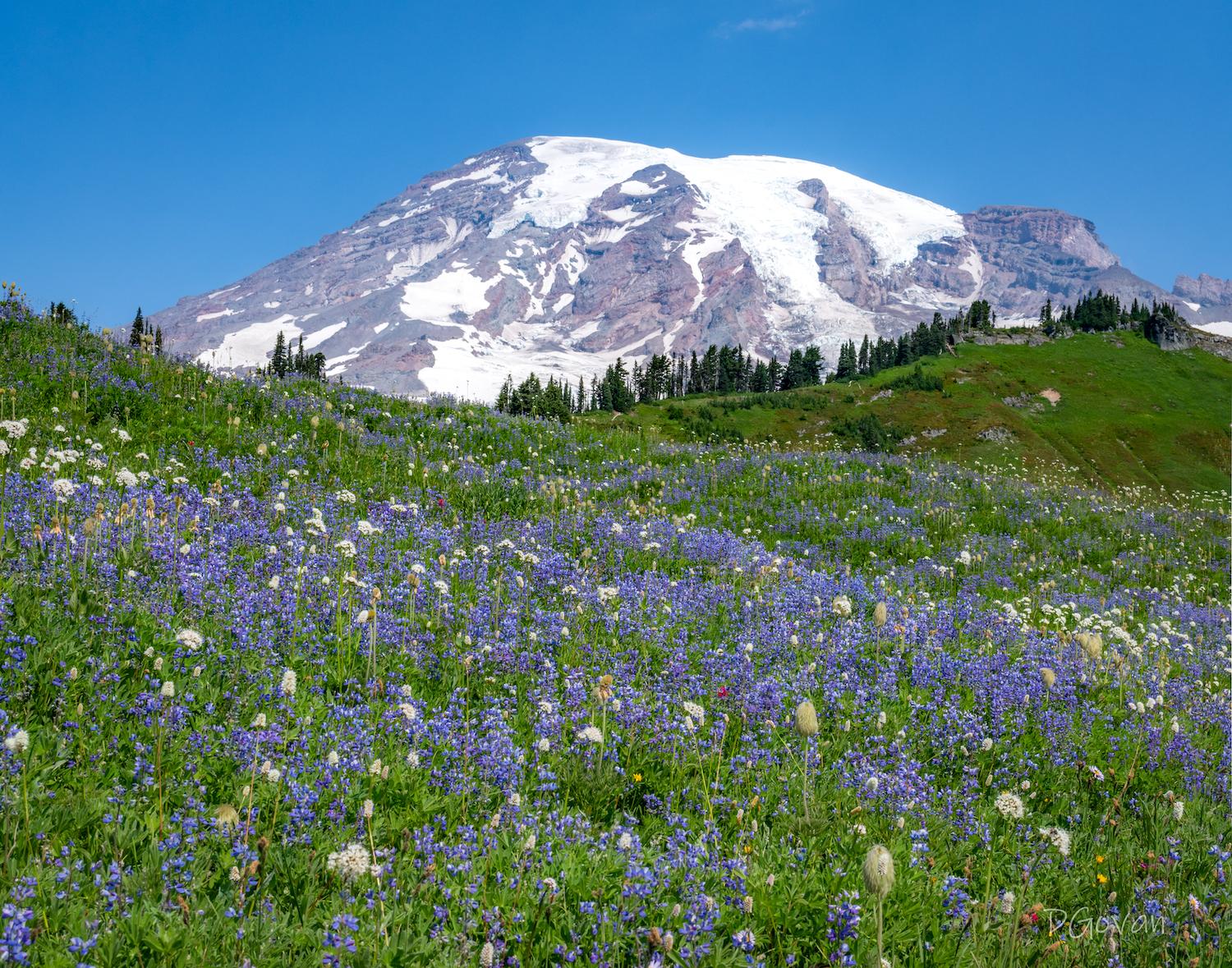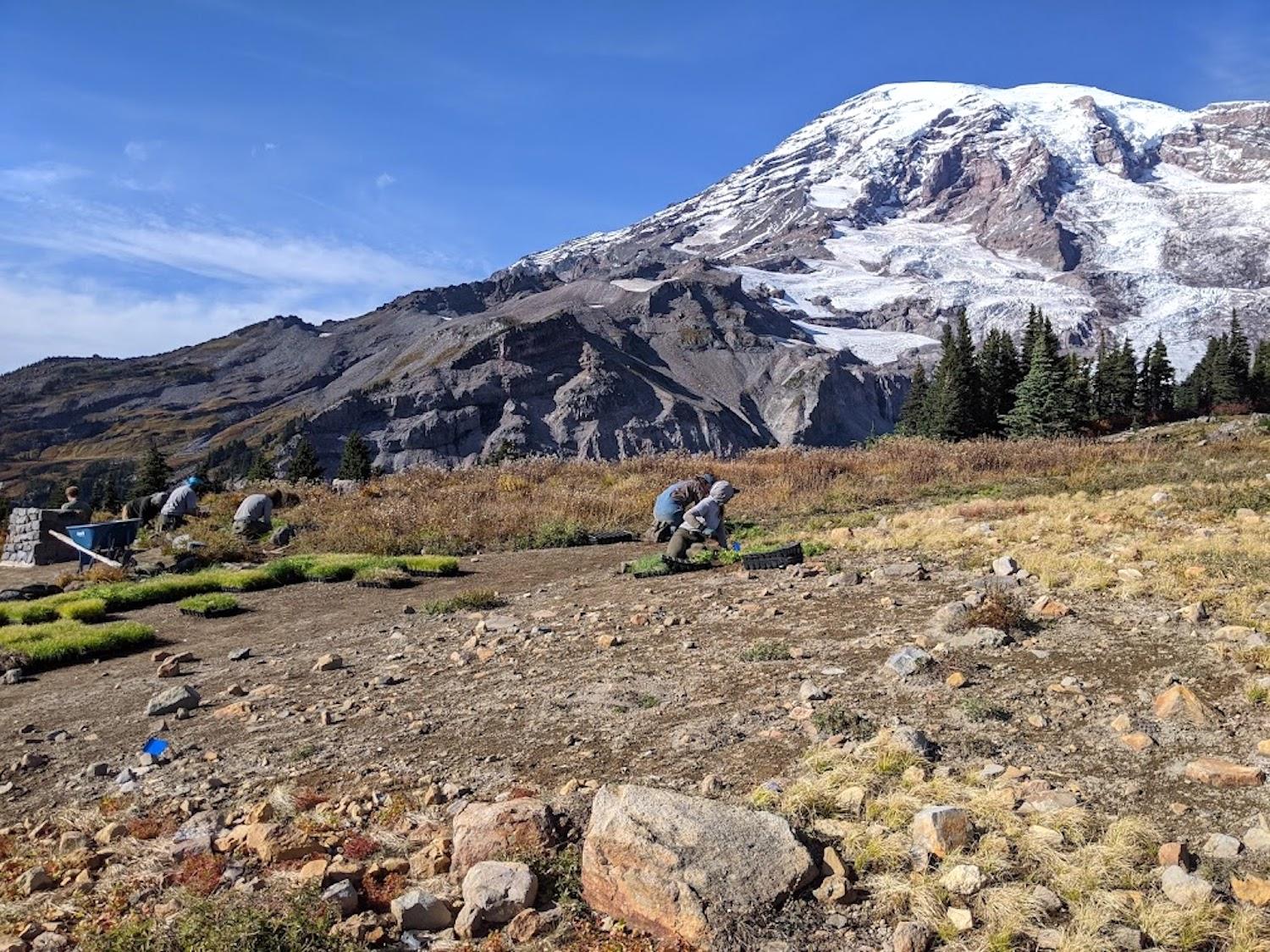
Wildflower meadows at Paradise make for spectacular views of the mountain/Dave Govan
Reviving Mount Rainier’s Wildflower Wonders
By Hugh Saffel, volunteer for Washington’s National Park Fund
Ask visitors to Mount Rainier National Park in Washington state to give you their most iconic memory, and many will grab their phone and scroll to photos of the wildflower meadows of Paradise. These thousands of acres of blooms provide a spectacular contrast of color to many of our favorite photos of the mountain. The alpine and sub-alpine meadows are some of the most accessible in the Cascade Mountains.
Unfortunately, this accessibility has led to decades of heavy use and off-trail hiking, leaving many of the areas trampled and bare. Reviving and maintaining these meadows for future generations is one of the many important park projects Washington’s National Park Fund donors make possible.
A Short Growing Season Requires Fast Work
Anyone who has done some hiking in wet country can appreciate why there is a need for this restorative work. With melting snow and rain, trails often get muddy. Feet tend to seek drier ground along the route, which erodes and expands the trail.
Off-trail tramping also adds significantly to the scarring of the meadows. While many of these plants are extremely tough, able to survive the crushing weight of dozens of feet of snowpack, a misplaced step can quickly snap even hearty heather branches setting their growth back years.
A growing season that is typically no more than three months long means that these plants don’t have enough time to recover on their own. This gives us a very small window to accomplish our goals.

Restoration crews plants native seedlings in trampled areas/NPS
Beth Fallon, Ph.D., is a plant ecologist at Mount Rainier National Park. She says, “Restoration starts with protection and conservation of the existing meadow system. This includes maintaining and building trails that create a system that is easy to follow and encourages visitors to stay on the trail, even in the snow.”

Meadow restoration efforts to conserve wildflowers improve the experience of the millions of visitors to Paradise every year/Dave Govan
This program involves staff and volunteers supplementing and stabilizing the soil in the meadow, then spreading seeds and planting plants. These plants are 40,000 native seedlings that have been grown from seeds collected in the meadows.
It’s Not Just About The Plants
These meadows are also home to all kinds of creatures — another reason it’s so important to maintain this important ecosystem. Black bears roam the meadows for huckleberries. White-tailed ptarmigan, red foxes, and wolverines roam the meadows in all seasons. Marmots are frequently seen munching on these plants, including some of the ones we’ve just planted!
These meadows also provide visitors with an amazing experience of diverse zones in a very short hike. You start near the tree line with sub-alpine firs before moving into a lush herbaceous meadow with huckleberries. Then, as you move into the alpine area, you leave the trees behind and experience heather with patches of snow still covering some of the ground. The sights and sounds and smells are all distinct. Lush areas of flowers buzzing with bees transition to areas still impacted by winter.
You get to experience all this, along with the animals who live here.
Donor Support Keeps This A Real Paradise
This important work wouldn’t get done without support from Washington’s National Park Fund. Donations support everything from the propagation of seedlings to paying the seasonal restoration staff for four weekends of volunteer efforts. It even supplies the tools and knee protection mats.
“Not only does the Fund help us achieve our annual goals of restoring sections of the meadow, but it also helps us involve more people in the effort.”
—Beth Fallon, Plant Ecologist at Mount Rainier National Park
Importantly, this project accomplishes more than just planting the plants. It helps Mount Rainier National Park engage more people in the effort and build more stewardship in the park. The more people the park can involve in these projects, the more they will understand the commitment it takes to maintain these special places.
The National Park Service aims to include marginalized and underrepresented people in this work in the parks. By working with groups like the Northwest Youth Corps and including students from local schools, young people are exposed to experiences that are new to them and are given the opportunity to see themselves in a scientific career.
Mount Rainier National Park restoration staff guides their learning in meadow ecology and restoration, providing a special opportunity for these young volunteers to have hands-on experience reviving the meadows and developing a connection to these special places they can continue to visit throughout their lives.
Get Your Hands Dirty
It’s up to all of us to provide for the national park that provide so much to each of us.
Giving your time is a great way to give back to the parks. Those interested in supporting other park projects involving science and research or volunteerism and stewardship can explore the options by visiting Washington’s National Park Fund’s project portfolio at wnpf.org/projects.

Many types of wildlife call the meadows home, including black bears, red fox, and marmots/Dave Govan

Comments
Gorgeous park and I appreciate the work being done to revitilize the wildflowers. My main question is how to stop social trails??? I have seen great restoration of trails with funding sources from government and non-profit sources. These trails are outstanding with wooden fencing, great layout of stone steps, proper signage to stay off sensitive areas, and beauiftiful vistas. Yet, even in this social trails always pop up to avoid that switchback or to see a better view of the landscape. How do we stop the social trails???